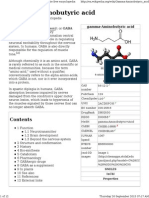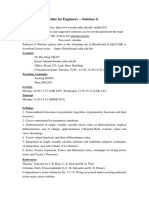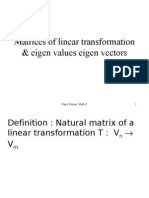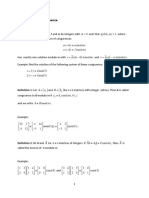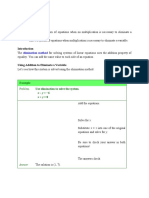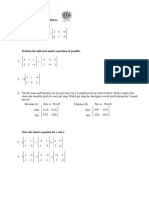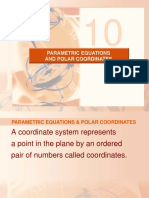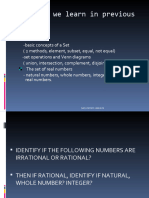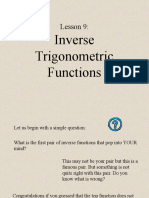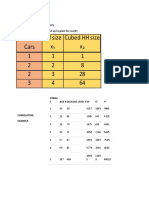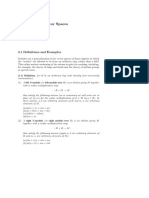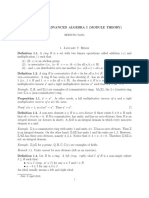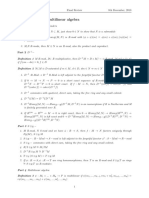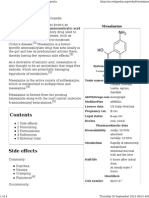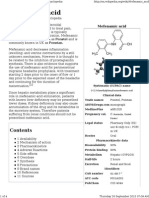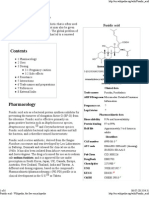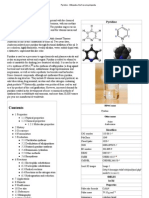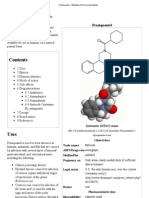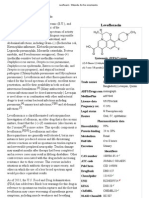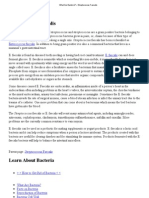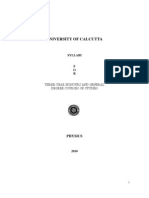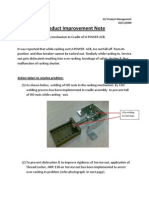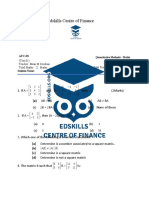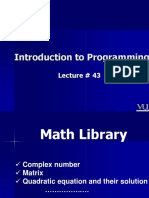Abstract Algebra
Abstract Algebra
Uploaded by
Ankan PalCopyright:
Available Formats
Abstract Algebra
Abstract Algebra
Uploaded by
Ankan PalOriginal Description:
Original Title
Copyright
Available Formats
Share this document
Did you find this document useful?
Is this content inappropriate?
Copyright:
Available Formats
Abstract Algebra
Abstract Algebra
Uploaded by
Ankan PalCopyright:
Available Formats
Module 2
Topic 1
Modules
Throughout, R will denote an associate ring with identity 1 = 0. Denition 1. Let R be a ring. A left Rmodule is an additive abelian group M together with a function R M M , where (r, m) is mapped to rm, such that for every r, s R and m1 , m2 M : (M 1) r(m1 + m2 ) (M 2) (M 3) (M 4) (r + s)m1 r(sm1 ) 1.m1 = rm1 + rm2 = rm1 + sm1 = (rs)m1 = m1 , where 1 is the identity element of R.
A right R-module M is dened similarly via a function M R R given by (m, r) mr and satisfying obvious analogues of (M 1) (M 4). We will denote a left(right) R-module M by
RM .
A module may
be regarded as a generalization of vector space. The scalar multiplication in the vector space by eld elements is replaced in a module by multiplication by arbitrary ring elements. Note: From now on, unless otherwise stated, R-module means a left R-module. Also it is understood that all theorems which hold for left R-module, also hold in a similar way for right R-modules. Let R be a commutative ring. Then it is easy to check that any left R-module is also a right R-module by dening m.r = rm. Hence for commutative rings, we do not distinguish between left and right R-modules.
Denition 2. Let R and S be rings. Then an abelian group M is called an (R, S )-bimodule if M is a left R-module as well as a right S -module such that the two scalar multiplication satisfy r(ms) = (rm)s. We will denote an (R, S )-module by R MS .
Suppose M is an R-module. Dene a map from R to End(M ), the ring of all group endomorphisms of M , by r fr , where fr (m) = rm m M . Now (fr + fs )(m) = rm + sm = (r + s)m = fr+s (m) and frs (m) = (rs)m = r(sm) = fr fs (m) m M implies that is a ring homomorphism. In fact R-modules
Copyright Reserved IIT Delhi
2 are completely determined by such ring homomorphisms. Suppose M is an abelian group and R is a ring such that there exists a ring homomorphism : R End(M ). Then my dening rm = (r)(m), M becomes an R-module. Elementary properties of an R-module M :
(i) 0.m = 0 m M (ii) r.0 = 0 r R (iii) (r)m = (rm) = r(m) r R, m M. Here 0 written on the right side is the zero of M and 0 on the left side is the zero of R.
Proof.
(i) rm = (r + 0)m = rm + 0m 0m = 0
(ii) rm = r(m + 0) = rm + r0 r0 = 0 (iii) 0 = 0m = (r + (r))m = rm + (r)m (r)m = (rm) 0 = r.0 = r(m + (m)) = rm + r(m) r(m) = (rm).
Examples of Modules:
1. Let M be any additive abelian group. Then M is a left and a right Z-module with respect to n.m = m + m + + m (n-times) n.m = (m) + (m) + + (m) (n-times). 2. Let M1 , ..., Mn be R-modules and let M = M1 ... Mn be the cartesian product of Mi s. Then M admits a natural R-module structure with respect to addition and multiplication given by (x1 , ..., xn ) + (y1 , ..., yn ) = (x1 + y1 , ..., xn + yn ) and r(x1 , ..., xn ) = (rx1 , ..., rxn )
3. Let R be any ring. Then R is left as well as right R-module. For r R, m R dene rm and mr to be the product of r and m as elements of R. In fact R is an (R, R)-bimodule. 4. Every R-module M is a Z-module, and hence is an (R, Z)-bimodule.
Copyright Reserved IIT Delhi
3 5. Let M = Mmn (R) = the set of all m n matrices over a ring R. Then M becomes an R-module under the multiplication r(aij ) = (raij ) r R. In particular, taking m = 1, M = Rn is an R-module. 6. Let S be a ring and R be its subring. Then S is an R-module with respect to the usual product in S . In particular the rings R[x1 , x2 , , xn ] and R[[x]] are R-modules. 7. Let I be a left ideal of a ring R. Then I is a left R-module with respect to usual product in R. Furthermore, the quotient group (additive) R/I is an R-module with r(s + I ) = rs + I . 8. Let A be an abelian group and let End(A) = R be the endomorphism ring of A. Then A is an R-module with f a = f (a), f R, a A. 9. Let R and S be rings and : R S be a ring homomorphism. Then every S -module M can be made into an R-module by dening rm = (r)m. It is said that the R-module structure of M is given by pullback along .
Copyright Reserved IIT Delhi
You might also like
- 6th Central Pay Commission Salary CalculatorDocument15 pages6th Central Pay Commission Salary Calculatorrakhonde100% (436)
- Sum and Differences IdentitiesDocument2 pagesSum and Differences IdentitiesAlonnah Marie RoblesNo ratings yet
- Gamma-Aminobutyric AcidDocument12 pagesGamma-Aminobutyric AcidAnkan PalNo ratings yet
- MATH1510G Calculus For Engineers - Subclass G: LecturerDocument2 pagesMATH1510G Calculus For Engineers - Subclass G: LecturerfishkantNo ratings yet
- Module Versus Vector Space (Extended Form)Document12 pagesModule Versus Vector Space (Extended Form)pksharma_davc2425No ratings yet
- Math 121 HW 1Document7 pagesMath 121 HW 1jaromarm44No ratings yet
- Module Requirement For Abstract AlgebraDocument6 pagesModule Requirement For Abstract AlgebraNimrod CabreraNo ratings yet
- Linear Algebra AssignmentDocument11 pagesLinear Algebra AssignmentLim Yan HongNo ratings yet
- 5 Linear Transformation of MatricesDocument53 pages5 Linear Transformation of Matricesalienxx100% (1)
- TRIG FUNCTIONS Lesson Solving Right TrianglesDocument52 pagesTRIG FUNCTIONS Lesson Solving Right TrianglesRudi BerlianNo ratings yet
- 2.3 Relation and FunctionDocument41 pages2.3 Relation and FunctionAlma G. FloridaNo ratings yet
- L6-L7-Matrices For Linear TransformationsDocument32 pagesL6-L7-Matrices For Linear TransformationsHarshini MNo ratings yet
- Vectors, Linear Combinations and Linear IndependenceDocument13 pagesVectors, Linear Combinations and Linear Independenceray hajjarNo ratings yet
- Chinese Remainder TheoremDocument7 pagesChinese Remainder TheoremManohar NVNo ratings yet
- Advanced Algebra MODULE Week 1-2Document247 pagesAdvanced Algebra MODULE Week 1-2Jun Dl CrzNo ratings yet
- Matrix PYQDocument4 pagesMatrix PYQJalilah RubaiNo ratings yet
- System of Linear Congruence: M M Ad BCDocument5 pagesSystem of Linear Congruence: M M Ad BCMimosaNo ratings yet
- Lesson 1 - Matrices and DeterminantsDocument43 pagesLesson 1 - Matrices and Determinantsgaryart111No ratings yet
- Mat423 Lecture Topic 4 VectorDocument79 pagesMat423 Lecture Topic 4 VectorMutmainnah ZailanNo ratings yet
- Unit 1: Measures of Central Tendency: Module 6: Descriptive Statistical MeasuresDocument10 pagesUnit 1: Measures of Central Tendency: Module 6: Descriptive Statistical MeasuresABAGAEL CACHONo ratings yet
- 3201 Chapter1Document7 pages3201 Chapter1JIGAR SAGARNo ratings yet
- Mathematical Induction PDFDocument6 pagesMathematical Induction PDFGAEA FAYE MORTERANo ratings yet
- Trig Exam 2 Review F07Document6 pagesTrig Exam 2 Review F07Rodion Romanovich RaskolnikovNo ratings yet
- 33 Simplified Radical FormDocument11 pages33 Simplified Radical FormJepot PascualNo ratings yet
- The Elimination Method Guided NotesDocument3 pagesThe Elimination Method Guided Notesapi-450522734100% (1)
- Notes For Abstract AlgebraDocument2 pagesNotes For Abstract AlgebraSankalp ChauhanNo ratings yet
- Elimination Matching ActivityDocument2 pagesElimination Matching ActivityVictoria SchererNo ratings yet
- Practice Test On MatricesDocument10 pagesPractice Test On MatricesowaisNo ratings yet
- Number Theory: Bachelor of Secondary EducationDocument1 pageNumber Theory: Bachelor of Secondary EducationRea Mariz JordanNo ratings yet
- The Exponential FunctionDocument18 pagesThe Exponential FunctionLucas BonifacioNo ratings yet
- Lesson 3. Division and Multiplication of Rational Expressions 1Document5 pagesLesson 3. Division and Multiplication of Rational Expressions 1Cristine Castulo PreguntaNo ratings yet
- Real Number SystemDocument32 pagesReal Number SystemJoy MendozaNo ratings yet
- Exponential and Logarithmic FunctionsDocument25 pagesExponential and Logarithmic FunctionsMukiNo ratings yet
- Algebraic ExpressionsDocument24 pagesAlgebraic Expressionsmanahilnasir67No ratings yet
- Parametric Equations and Polar CoordinatesDocument112 pagesParametric Equations and Polar CoordinatesZazliana IzattiNo ratings yet
- 10 - 1 Simplifying Rational Expressions Trout 09Document14 pages10 - 1 Simplifying Rational Expressions Trout 09Vehid KurtićNo ratings yet
- Solving Trig EquationsDocument12 pagesSolving Trig Equationsapi-285179261No ratings yet
- Z0185001022015402412-13 Eigenvalues and EigenvectorsDocument30 pagesZ0185001022015402412-13 Eigenvalues and EigenvectorsYeni NuraeniNo ratings yet
- 3.3 Function NotationDocument13 pages3.3 Function NotationEzekiel ArenzNo ratings yet
- Basic Matrix Operations: Example 1)Document4 pagesBasic Matrix Operations: Example 1)gaurav775588No ratings yet
- Fields and RingsDocument32 pagesFields and RingsRam babuNo ratings yet
- Mathm109-Calculus II - Module 3Document20 pagesMathm109-Calculus II - Module 3richard galagNo ratings yet
- Chapter 6 Binomial CoefficientsDocument21 pagesChapter 6 Binomial CoefficientsArash RastiNo ratings yet
- 8.1 Worksheet Polar CoordinatesDocument3 pages8.1 Worksheet Polar CoordinatesRonnieMaeMaullionNo ratings yet
- College AlgebraDocument30 pagesCollege AlgebraGelvie LagosNo ratings yet
- Matrices UpdateDocument6 pagesMatrices Updateapi-349545585100% (1)
- IsomorphismDocument5 pagesIsomorphismHabtu Reda BerheNo ratings yet
- Depedpang 1Document127 pagesDepedpang 1Bayoyong NhsNo ratings yet
- Lesson 9 - Inverse Trigonometric FunctionsDocument28 pagesLesson 9 - Inverse Trigonometric FunctionsLory Mae AlcosabaNo ratings yet
- Systems of Linear Equations and MatricesDocument49 pagesSystems of Linear Equations and Matricesgosaye desalegnNo ratings yet
- Math 131 - Action Research in Mathematics EducationDocument9 pagesMath 131 - Action Research in Mathematics EducationAngel Guillermo Jr.No ratings yet
- Review in TrigoDocument5 pagesReview in TrigoJohnMichaelM.ManaloNo ratings yet
- Mean Median Mode Grouped Data.Document21 pagesMean Median Mode Grouped Data.John Carl YomeroNo ratings yet
- Trigonometry WorkbookDocument20 pagesTrigonometry WorkbookElaine zhuNo ratings yet
- Problem Solving Mathematics - Lesson 1Document27 pagesProblem Solving Mathematics - Lesson 1Nishinoya KenNo ratings yet
- Worksheet On Angles and Radian MeasureDocument4 pagesWorksheet On Angles and Radian MeasureJose Emmanuel Sarumay ManingasNo ratings yet
- 4 - 7 Inverse Trig Functions LESSON NOTES PPDocument24 pages4 - 7 Inverse Trig Functions LESSON NOTES PPRay CancinoNo ratings yet
- Composite Function Classification of FunctionDocument12 pagesComposite Function Classification of FunctionanandNo ratings yet
- Regression Correlation ActivityDocument2 pagesRegression Correlation ActivityXiaoyu KensameNo ratings yet
- AWchap 3Document75 pagesAWchap 3hungnotphakeNo ratings yet
- ModulesDocument10 pagesModulesKanchit SaehoNo ratings yet
- ModuleDocument40 pagesModulemalikawan20dNo ratings yet
- 1 Modules and Multilinear AlgebraDocument3 pages1 Modules and Multilinear AlgebraJordi ArnauNo ratings yet
- Mesalazine: Mesalazine (INN, BAN), Also Known As Mesalamine (USAN) or 5-Aminosalicylic AcidDocument4 pagesMesalazine: Mesalazine (INN, BAN), Also Known As Mesalamine (USAN) or 5-Aminosalicylic AcidAnkan PalNo ratings yet
- Mefenamic Acid Is A Non-SteroidalDocument4 pagesMefenamic Acid Is A Non-SteroidalAnkan PalNo ratings yet
- Fusidic Acid - Wikipedia, The Free EncyclopediaDocument6 pagesFusidic Acid - Wikipedia, The Free EncyclopediaAnkan PalNo ratings yet
- Pyridine - Wikipedia, The Free EncyclopediaDocument15 pagesPyridine - Wikipedia, The Free EncyclopediaAnkan Pal100% (1)
- Praziquantel - Wikipedia, The Free EncyclopediaDocument6 pagesPraziquantel - Wikipedia, The Free EncyclopediaAnkan PalNo ratings yet
- Levofloxacin - Wikipedia, The Free EncyclopediaDocument19 pagesLevofloxacin - Wikipedia, The Free EncyclopediaAnkan PalNo ratings yet
- What Are Bacteria - Streptococcus FaecalisDocument3 pagesWhat Are Bacteria - Streptococcus FaecalisAnkan PalNo ratings yet
- Ofloxacin - Wikipedia, The Free EncyclopediaDocument20 pagesOfloxacin - Wikipedia, The Free EncyclopediaAnkan PalNo ratings yet
- PhysicsDocument28 pagesPhysicsAniket DeyNo ratings yet
- Pin Racking Mech U-PowerDocument2 pagesPin Racking Mech U-PowerAnkan PalNo ratings yet
- Differences Between Generations of CephalosporinsDocument3 pagesDifferences Between Generations of CephalosporinsAnkan PalNo ratings yet
- PIN New FSD Connector 20122010Document1 pagePIN New FSD Connector 20122010Ankan PalNo ratings yet
- TC SyllabusDocument3 pagesTC SyllabusDivya DevhariNo ratings yet
- W-13 Solving The Linear Equation Systems by Iteration MethodDocument24 pagesW-13 Solving The Linear Equation Systems by Iteration Methodumuhuza salomonNo ratings yet
- Maths Chap 4 Continuity of Functions NotesDocument10 pagesMaths Chap 4 Continuity of Functions NotesankushNo ratings yet
- Notes On The Lebesgue Integral: Revised, 9/5/2021Document10 pagesNotes On The Lebesgue Integral: Revised, 9/5/2021MRNo ratings yet
- Measure July 20 2021Document13 pagesMeasure July 20 2021jayaram prakash kNo ratings yet
- Orthographic Projection 正 角 投 影 圖: Plan 平 面 圖Document5 pagesOrthographic Projection 正 角 投 影 圖: Plan 平 面 圖go goNo ratings yet
- Linear Functionals and Dual Spaces PDFDocument70 pagesLinear Functionals and Dual Spaces PDFShruti Sharma100% (3)
- 06 Finite Elements BasicsDocument28 pages06 Finite Elements BasicsPankaj SainiNo ratings yet
- Portfolio Sa MathDocument42 pagesPortfolio Sa MathMaria Kristine JazminNo ratings yet
- K0292001022011402301 MatrixDocument34 pagesK0292001022011402301 Matrixcynthiamia30No ratings yet
- Random Variable - TransformationsDocument35 pagesRandom Variable - Transformationsmonica_804238794No ratings yet
- Clifford Algebra, Geometric Algebra and Applications - Lundholm, DDocument137 pagesClifford Algebra, Geometric Algebra and Applications - Lundholm, DRodrigo LedesmaNo ratings yet
- ArithmeticDocument17 pagesArithmeticRose Eden AbitongNo ratings yet
- Fmla PDF NotesDocument43 pagesFmla PDF NotesCheung ChristopherNo ratings yet
- 1 Fourier Series: 1.1 The Complex Exponential FormDocument7 pages1 Fourier Series: 1.1 The Complex Exponential FormTanzina ArpaNo ratings yet
- G11 1ST SEM QUARTER1 TOS GenMathDocument3 pagesG11 1ST SEM QUARTER1 TOS GenMathRuby Ann Almazan MatutinoNo ratings yet
- Descrete QDocument2 pagesDescrete QDave Olivar TorresNo ratings yet
- Section 10.21 (04PN) Open and Closed Subsets of Spectra-The Stacks ProjectDocument1 pageSection 10.21 (04PN) Open and Closed Subsets of Spectra-The Stacks ProjectguzhNo ratings yet
- Computer Programming (TKK-2144)Document44 pagesComputer Programming (TKK-2144)Andika SuryaNo ratings yet
- A2 Test 1 FinalDocument4 pagesA2 Test 1 FinalAbdul ToheedNo ratings yet
- NCERT Solutions For Class 12 Maths Chapter 3 MatricesDocument77 pagesNCERT Solutions For Class 12 Maths Chapter 3 MatricesKeerthi KeerthiNo ratings yet
- Laplace Transformation TableDocument1 pageLaplace Transformation TableDj100% (1)
- Linear SpanDocument5 pagesLinear SpanLalaNo ratings yet
- MATH 106: 1 Line IntegralsDocument7 pagesMATH 106: 1 Line IntegralsYa BoyNo ratings yet
- CS201 43Document34 pagesCS201 43Abdul Hannan SohailNo ratings yet
- Trial QuestionsDocument8 pagesTrial QuestionsFORSON ADU-GYAMFI JOSEPHNo ratings yet
- Calculus SolutionsDocument1,819 pagesCalculus SolutionsReeze Vreena TamarayNo ratings yet
- Practice Paper (XIIMathematics)Document190 pagesPractice Paper (XIIMathematics)a4776847719No ratings yet
- Module2-Signals and SystemsDocument21 pagesModule2-Signals and SystemsAkul PaiNo ratings yet


